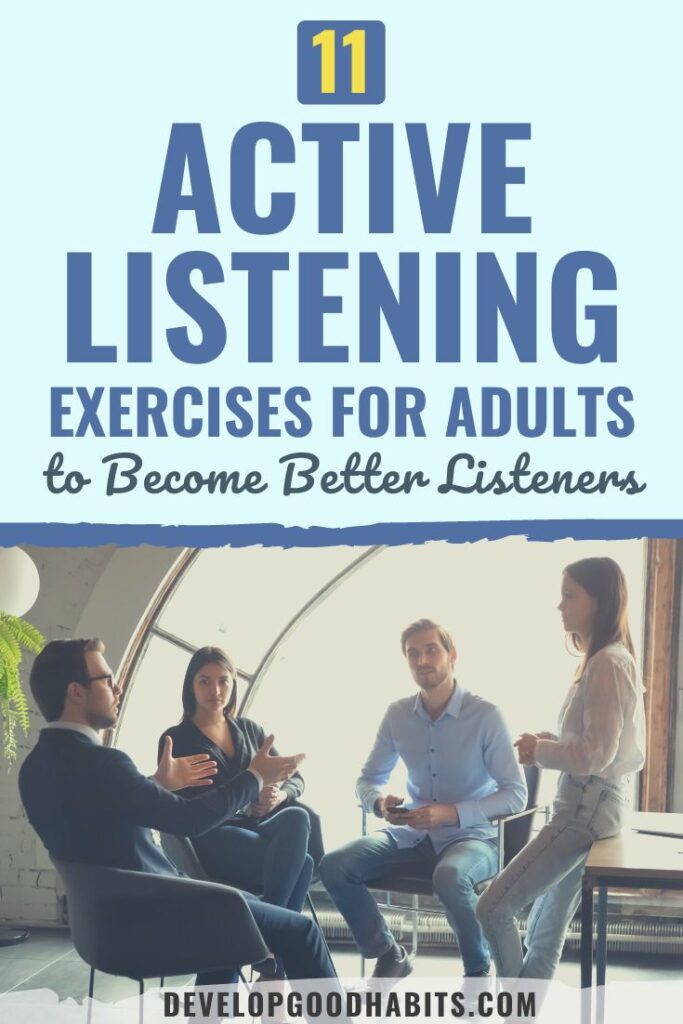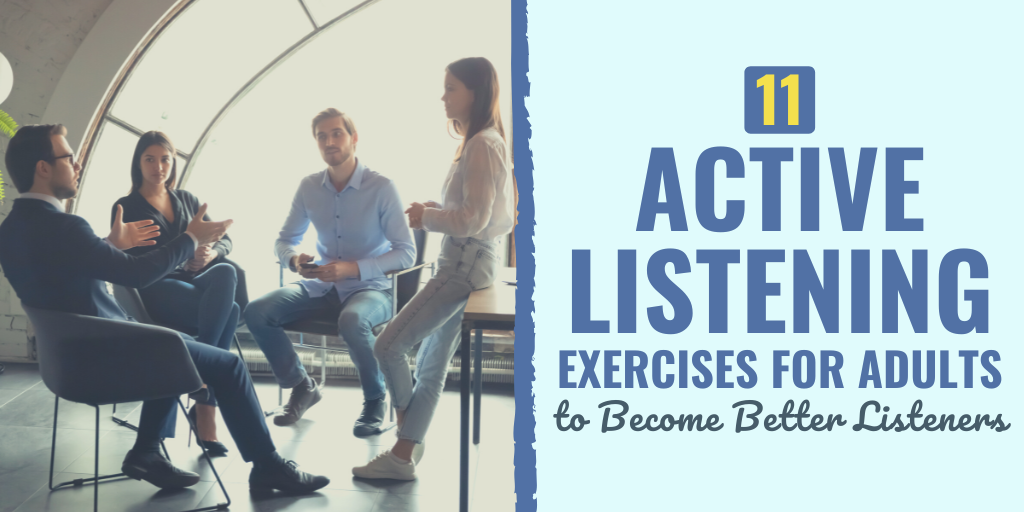11 Active Listening Exercises to Become A Better Listener Leave a comment
Have you ever witnessed a conversation in which one person constantly interrupts or talks over the speaker? How well was the speaker’s message being understood by the listener? How much message do you think the listener retained after walking away?
Not only does this common listening error convolute the speaker’s message for those who are listening, it also costs the interrupter the opportunity to learn something new.
In such a situation, the interrupter is not practicing active listening, which means he is simply replying to the message rather than taking the time to understand it.
Active listening is a useful skill for any adult to develop because it helps one absorb what other people are saying rather than just what one wants to or thinks they hear. This listening skill is fundamental to building trust, connection, and rapport.
Everyone could use some brushing up on their communication skills, so in this article, we will look at 11 active listening exercises and how you can use them to your advantage in your personal and professional interactions.
But first, let’s take a deeper look at active listening.
What Is Active Listening?
The term “Active Listening” was coined in 1957 by psychologists Carl Rogers and Richard Farson. This soft skill is learned by making the conscious decision to put one’s thoughts aside and absorb and understand what someone is saying without passing judgment.
This involves paying close attention, avoiding the urge to interrupt, and having the patience to learn what the speaker is saying. The unique thing about active listening is that the goal is to understand instead of just listening.
Research shows that three qualities define active listening:
Active listeners use verbal and nonverbal cues and behaviors, such as making eye contact, maintaining an open posture, and displaying appropriate facial expressions, to signal undivided attention.
Active listeners can communicate comprehension by paraphrasing what the speaker has said and asking clarifying questions. The “active” component involves interacting with the speaker to uncover details that might not have been shared initially.
Finally, active listening involves showing positive intention by maintaining an interested, non-judgmental attitude.
It is important to note that a nonjudgmental attitude doesn’t mean one must agree with what the speaker is saying; it just acknowledges the speaker’s perspective.
Active listening demonstrates respect for the speaker’s worth, considering his or her perspectives and ability to reach reasonable conclusions.
In return for understanding what other people want you to know, you will be able to offer support and empathy through your habit of active listening. This can help the speaker feel validated and heard. But to be effective, users must maintain active listening as a basic attitude.
If active listening is not a fundamental mindset, your behavior won’t be genuine, which will be easily recognized by those with whom you’re conversing.
Carl Rogers and Richard Farson originally found several benefits to learning this skill, and the positive impacts of active listening have continued to grow. Here are some reasons why active listening is beneficial:
The good thing about this soft skill is that it can be developed with time and practice. It is about focusing and seeing things from new perspectives to expand or challenge one’s knowledge.
With these benefits in mind, let’s look at some active listening exercises you can practice to become a more effective listener.
11 Active Listening Exercises for Adults to Become Better Listeners
1. Silence Isn’t Always Golden
Participants should break into groups of two or three for this exercise and have one dedicated speaker. Instruct the speaker to tell a significant story about their life, like a big accomplishment or challenge they have overcome.
As they speak, have the listeners remain silent and maintain a straight facial expression.
After the speaker tells their story, debrief by asking what this felt like for each person. Some questions to consider may include:
This exercise can help demonstrate the difference that active listening makes for both the listeners and the speakers. It can help listeners understand the value of offering appropriate feedback when someone is speaking.
This activity can easily be applied to everyday life when conversing. It is a great reminder to interact with anyone taking the time to communicate with you to allow them to feel heard.
2. Cue the Nonverbals
For this activity, each participant will need paper and a pen. Have everyone create a list of non-verbal cues that listeners often display. Then, each player will act out one of the behaviors they identified while the other players decipher the meaning.
While one person displays a nonverbal behavior, have everyone else write down the message.
Some non-verbal cues may include:
After each round, ask the participants to share how each nonverbal cue made them feel. Then, talk about how a nonverbal cue could communicate a message that is even stronger than words. Have participants share their past experiences of how nonverbal cues have impacted their communication.
This exercise helps participants identify nonverbal communication cues and can help trigger people’s memories during future conversations so they avoid displaying these behaviors.
3. Listen and Repeat
People are often eager to “get a word in” when listening to someone else talk. For this activity, divide a group into pairs and have each person tell their partner about something that is important to them for about three minutes while the other person listens quietly.
After the speaker has finished, have the listener paraphrase what they heard in their own words.
The speaker can then clarify, correct, or confirm the listener’s interpretation.
This game has a few objectives. First, it can help listeners build patience as they cannot interrupt the speaker. Second, it can help train participants to stop thinking about what they want to say in response and focus solely on the speaker’s message. In doing so, they will be able to demonstrate an understanding of what the speaker said.
4. I Respect Your Viewpoint
This activity aims to help people practice restraint in reacting to others’ opposing viewpoints and keep an open mind.
This should not involve an argument or confrontation–it should be a friendly conversation to help players get into the habit of listening unbiasedly, even when speaking with someone who has a different viewpoint than your own.
For this exercise, you will need two people with opposing viewpoints on a subject. Each participant must patiently listen to the other’s point of view and try to learn and truly understand how their partner reached their conclusions.
After each participant explains their point of view, the other person is then given a chance to ask relevant questions to help further their understanding of the opposing viewpoint. Some questions that demonstrate active listening could include:
Completing this activity should help you improve your ability to have meaningful conversations by encouraging you to listen to learn about a different perspective actively.
To listen effectively, keep an open mind and don’t focus on your thoughts or feelings about the topic—pay attention to what your partner is saying so you can effectively hear what they’re saying. Using this skill in future conversations can help reduce conflict and increase understanding.
5. The Drawing Game
This activity is good practice for future situations where a listener can’t respond to the speaker, perhaps in a lecture or if the speaker is recorded.
For this activity, have a leader give verbal instructions to participants detailing how to draw something without allowing the listeners to ask any questions. The object of the picture can be anything, but the more instructions involved, the better.
Some instructions could be, “draw three squares with one star on top of the first square, then draw a circle next to the star…” and so on. This activity will demonstrate how important it is to listen clearly when someone is trying to communicate something to you, and you can’t ask questions in return.
Ensure the game is challenging enough that participants must concentrate very well to follow the instructions and correctly draw the picture. The activity can become increasingly difficult with every instruction, so they won’t correctly complete the exercise unless the participants actively listen.
6. Right vs. Wrong
Active listening is important in this activity because players identify truths and lies on a subject. This translates into real life, as active listeners must pay attention and listen with a discerning ear when gathering information from others.
This activity requires one speaker and a small group of listeners. The speaker can pick any subject that interests the group and then talk about it for about one minute.
The speaker needs to be knowledgeable about the topic because they’re tasked with telling the group several facts about it–but the catch is that the speaker will also make a handful of false statements about it.
The players must listen carefully to catch the untrue statements the speaker says. The speaker should only say each sentence once, so it’s essential for the players to listen very carefully.
Depending on the topic, players may need to concentrate on paying attention, using their brain capacity to think about the subject, and listening for factual information. Try choosing the topic as a group so everyone can recognize the sentence errors.
7. Storytime
For this activity, one person narrates a story while everyone else listens. Once the story is over, each participant is given a set of questions about it, ranging from easy to complex. The group has to answer the questions based on the story they heard.
This activity will show if each person listened well enough to understand and remember the story they were just told.
Another way to play this game is to play a short video or podcast and then have the participants rewrite the story in their own words, including as many details as possible.
This activity translates into everyday life because it provides active listening practice to ” teach back” the story. The teach-back learning method helps people understand the information they’re given.
8. Intentional Contradiction
You can also use the intentional contradiction activity, a more adult-appropriate version of the classic kids game called Simon Says. You and your team can practice your active listening skills in a small or large group, making this activity applicable in different settings.
Plus, you can use this activity as an icebreaker, too!
Here’s how to play intentional contradiction:
- Pick a team leader and let your team form a circle around the leader. You can also have one leader per round, giving others a chance to “lead” the activity.
- The leader gives the team two actions when certain items are mentioned. For example, the leader will tell the team that when they say “water,” the participants must raise their left hand, while the participants must put their right foot forward when the leader says “tea.” The leader also needs to do these actions when they say those terms.
- The goal of the activity is contradiction, so the participants need to do the opposite—put their right foot forward when the word “water” is mentioned and raise their left hand when the word ” tea” is mentioned.
- So, the leader can start just speaking the words and doing the actions as instructed, and the participants need to do the opposite. Whoever doesn’t contradict the team leader, exits the game (or doesn’t become team leader for X rounds). Or the leader can weave a story and do the actions when the words “water” and “tea” are mentioned.
The participants need to listen actively and closely and pay attention so they can contradict the leader’s actions and win (be the last team member standing to become the next leader or win a prize).
9. Train of Words
This activity reminds me of a version of the kids’ game “telephone” or “Chinese whispers.” It focuses on active listening as a skill because the participant(s) need to pay close attention and practice their summarizing skills.
The active listening activity is called the train of words or the listening chain, and here’s how you set it up:
- Let all the participants sit or stand in a circle.
- Choose the first participant who is interested in a topic. You can let them choose a topic on their own or let them draw a post-it note (with a topic) from a hat.
- They must whisper a sentence or two about the topic to the person to their left (or right – decide if you want to go clockwise or anticlockwise around the circle).
- The second person then whispers the sentence or two to the next person, and so on until the circle is complete.
- The last person needs to tell everyone what was shared with them, and it is about 99% likely that the original sentence’s meaning will be distorted to an extent.
A variation of this listening game is to have the participants spread out across a large hall. One person goes to the next and shares the story that the first participant told the second team member.
At the end, have the participants form a circle and let the last participant share the story they heard as accurately as possible.
10. Background Noise Listening
It’s usually easier to listen and pay attention when it’s quiet, but when background noise is added to the mix, it really tests your listening skills. That’s exactly the purpose of this active listening activity.
This activity requires a large group; alternatively, you can record and/or play background noise over a sound system.
Here’s how to do this activity:
- In a group of 15 to 20 participants, choose six to eight to be the noisemakers. Instruct them to make as much noise as possible, potentially even starting with less noise and upping the ante.
- Choose a speaker who’ll talk about an interesting topic.
- Once the speaker starts speaking, the noisemakers need to make noise while the rest of the participants try to listen to what the speaker is saying. The listeners can take notes of what the speaker is saying, or you can make the activity more challenging and have the listeners close their eyes so they can’t infer meaning from the speaker’s non-verbal cues.
- At the end, ask the listeners to share what they heard.
11. Blindfold Obstacle Course
The blindfold obstacle course, or blindfold walk, is another excellent active listening exercise since it teaches communication and listening skills.
You can use an ample indoor or outdoor space for the activity, and obstacles are a must.
Here are the instructions for the blindfold obstacle course or walk:
- Choose an area with natural obstacles or put obstacles in the space the participants need to navigate.
- Pair up the participants.
- One person in each pair needs to be blindfolded.
- The person who isn’t blindfolded will instruct the blindfolded team member on how to navigate the obstacle course safely.
The point is that you want the blindfolded to safely navigate the course without obstacles and the non-blindfolded to instruct and guide their partners clearly.
Final Thoughts on Active Listening Exercises
So there you have it, 11 active listening exercises that you can do to help you sharpen your listening skills.
Hopefully, you can integrate some of these activities into your schedule so you can work on becoming an active listener and help others do the same.
For more activities for successful listening, check out these articles:


Connie Mathers is a professional editor and freelance writer. She holds a Bachelor’s Degree in Marketing and a Master’s Degree in Social Work. When she is not writing, Connie is either spending time with her daughter and two dogs, running, or working at her full-time job as a social worker in Richmond, VA.



